|
ZIPPER OFFENSE
During the 1960's, the Boston Celtics were successful in winning a longer string
of consecutive championships than any team in the history of professional sports
running the zipper offense. This offense has been used for a variety of
reasons to either enter into an offense or to run it as an offense all to its
own. This article will discuss the advantages and disadvantages of the
zipper offense as well as ways to run it, some plays that go along with it, and
ways to teach this outstanding offense to your players.
Advantages of the Zipper Offense
There are a number of reasons as to why a coach would want to run the zipper
offense. They include:
-
Versatility. The zipper offense can be run
from a number of different sets. Anything from a 2-1-2 set to
a 1-2-2 box to a 1-4 high set can be used to get into the offense.
This allows the coach to use different formations to run the same
basic plays.
-
The ability to run multiple plays. Because
there are several plays that can be run using the zipper set, you
can adjust the offense to your personnel. I will show a myriad
of plays that will provide some ideas as to how you can run the
offense to best fit what your players can do well.
-
The ability to enter into another offense. The
zipper preset can be used to get into motion offense, flex offense,
shuffle offense, or a pick-and-roll offense easily. By running
the basic preset, the zipper offense can be used as a quick hitter
to score right away or to get into the offense if the quick hitter
doesn't score right away.
Disadvantages of the Zipper Offense
However, like most set offenses, the zipper offense does have its disadvantages
which include the following:
-
Like most set offenses, the zipper offense can be
easily scouted. Because the offense relies on specific calls
to run specific plays, the offense is tipped off to the people in
the stands, including opposing coaches watching the game. The
only way to counteract coaches from picking up on your calls and
tendencies is to have a high volume of offensive plays from the set.
-
The zipper offense also requires that you need to
have certain elements of offense that your defense sees on a regular
basis. This requires that your team spend separate practice
time working on other offensive concepts that are not incorporated
in your set offense.
-
Putting in the zipper offense also means that you
will need to have another offense that you can enter into once you
have run the quick hitting play without attempting a shot. If
you choose not to have an offense that your team can easily flow
into, your team will require quick shots out of the zipper offense.
Those quick shots could ultimately mean the difference between
winning and losing games.
Basic Zipper Plays
When entering the zipper offense, we have four basic reads for our point guard
when entering into the offense. The first read is the back cut by the
wing. If we are playing a pressure defense, we can look to get this entry
by having the wing fake high then cut back door (Diagram 1). A defender
actively denying the wing will be brought out away from the basket creating a
moment of separation where our point guard can enter the ball to the cutter for
a lay-up.
The second option for the point guard is to turn the corner if his defender is
guarding him too high. In Diagram 2, the defender is shown as being too
high and too far behind the dribbler. We give the point guard some
latitude to attack the rim if this develops; however, we will hold the point
guard accountable.
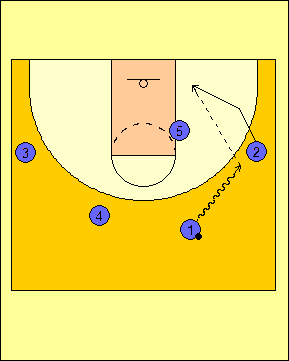
Diagram 1 |
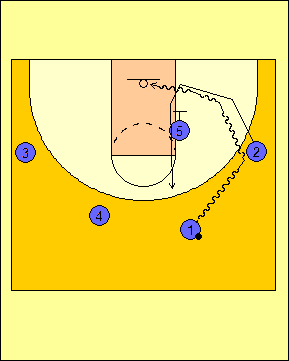
Diagram 2 |
The third option is how we read the down screen. This works two ways:
The first is that the cutter comes off of the down screen cleanly and the
defense doesn't switch the screen as shown in Diagram 3. We look for the
cutter first and will pass him the ball. If he gets the ball, we will run
the play. If he gets overplayed, we will dribble him out with a back cut
as shown in Diagram 4.
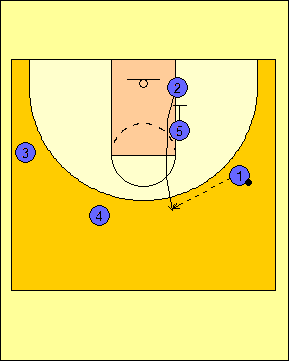
Diagram 3 |
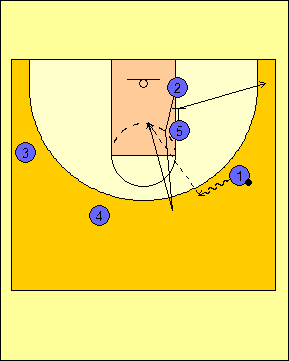
Diagram 4 |
The fourth option is the post up. This works one of two ways: The
first is that the post man comes open after setting the screen and the cutter
receives the pass. We only look for this post up if the screener does not
have to get involved in the play as a screener (Diagram 5).
The other is when the screen gets switched by the defense. Here, we want
to go right inside and exploit the switch to our advantage (Diagram 6).
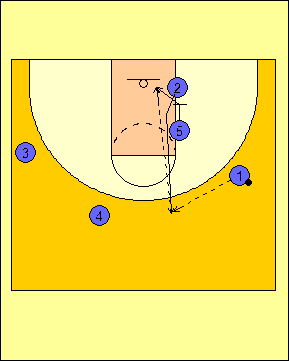
Diagram 5 |
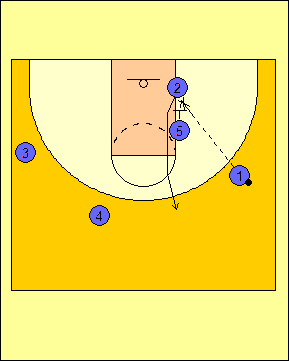
Diagram 6 |
One variation of the zipper offense is to use a back screen instead of the usual
down screen. This little change is what we call a "Utah" cut. Here,
the wing sets a back screen for the play-side post player to bring him into the
low post. The progression of reads for the point guard changes as he will
look back cut, turn the corner, post up and wing on high (to the spot or on the
backdoor) in that order. The change of looking into the post first instead
to the wing is made because of how the screening action is set on the "Utah" cut
instead of the zipper cut (Diagram 7). If they switch, we will look to
take advantage of the switch by looking to pass to the screener and set up a
one-one-one situation with the post man's defender one-on-one with the wing
(Diagram 8).
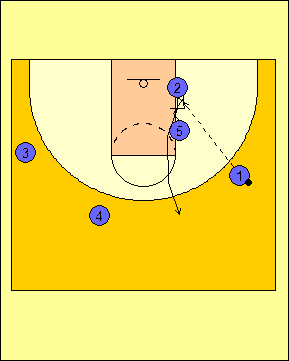
Diagram 7 |

Diagram 8 |
Here are some basic plays that can be run from the zipper set:
1. The regular play. Once in a while, we might get lucky and get a great
shooter a wide-open look off of the zipper cut or even get the ball into the
post immediately. If we do not get either of these, we can then go into
other options. Typically, these options will be called from the set.
2. "Go" (Diagram 9). This play is really a change of pace when running
the zipper offense. Instead of passing the ball to #2, we run the
pick-and-roll on the side with #5 coming out to set the ball screen for #1.
#2 and #3 spot up while #4 dives to the help-side short corner.
3. "Fist" (Diagram 10). On this play, #2 dribbles at #4 forcing
him to the basket on a back cut. If #4 is open, we want him to get the
ball. If not, #4 will go to the opposite short corner while #2 passes to
#3. From here, #3 will get a ball screen from #5 and go into a sideline
pick-and-roll.
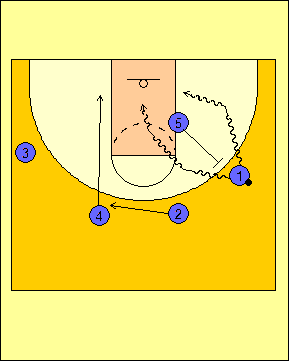
Diagram 9 |

Diagram 10 |
4. "Dive" (Diagram 11). This play is similar to "Fist" except
that instead of running the pick-and-roll, #4 screens away for #5 and brings him
to the ball-side low block.
5. "Philly" (Diagram 12). We run "Philly" as a pick-and-pop play
for our #2 and #4. #2 will read what the defense does and act accordingly.
He can penetrate to pass or attack the rim, spot up and shoot or pass back to
#4.

Diagram 11 |

Diagram 12 |
6. "Shuffle" (Diagrams 13 and 14). Diagram 13 shows a down
screen by #4 on #3 and a back screen by #5 on #1 who makes a shuffle cut.
#2 can then pass to either #1 off of the shuffle cut or #3 off of the down
screen.
Diagram 14 shows what happens when the ball is passed to #3 off of the down
screen. #4 sets a down screen for #1 and #5 sets a flare screen for
#2.
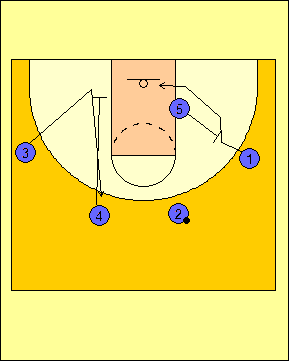
Diagram 13 |
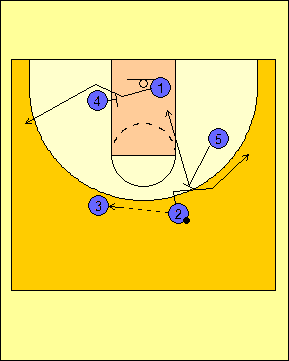
Diagram 14 |
7. "Pinch" (Diagrams 15 and 16). Diagram 15 shows #3 cutting to
the same side of the floor as #1 and #2 while #4 acts like he is going to set a
screen, but will instead flash to the elbow opposite #1 and #2 to set up the
pinch post game. In Diagram 16, #2 and #4 work the two-man game from the
pinch post.
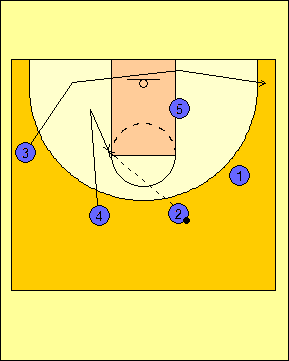
Diagram 15 |
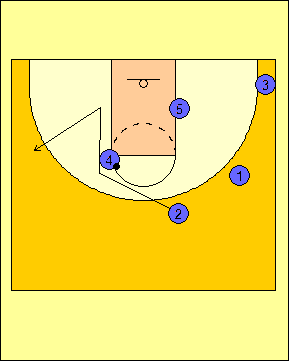
Diagram 16 |
8. "Triple" (Diagram 17). Triple sets up like Shuffle except
that #3 and #4 set a double-down screen for #1 as #2 looks to get him the ball
in the opposite corner for a quick shot.
9. "Choice" (Diagram 18). Choice is a variation of Triple in
that #1 can either come off of a single-down by #5 or a double down set by #3
and #4.
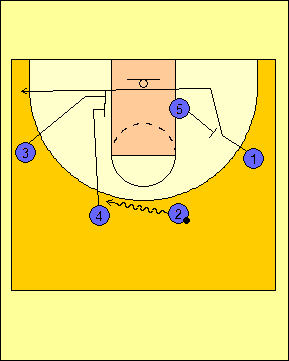
Diagram 17 |
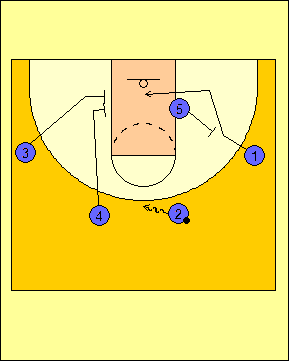
Diagram 18 |
10. "Horns" (Diagram 19). #3 clears to the ball-side corner
while #1 comes off of a stagger double set by #4 and #5. Once #1 gets the
ball, he will set up a post entry with #4 by dribbling to the wing looking to
get the ball to #4.
11. "Drag" (Diagram 20). This is based off of one of North
Carolina's counters in their secondary break. #4 comes to the ball to set
a ball screen for #2. #3 spots up and #5 rolls to the opposite block while
#1 sets a back screen by way of the low block on his side for #4.
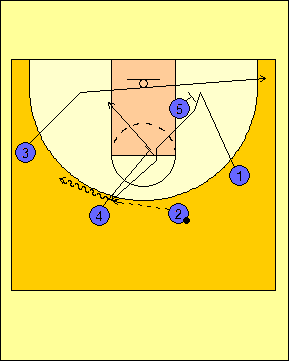
Diagram 19 |
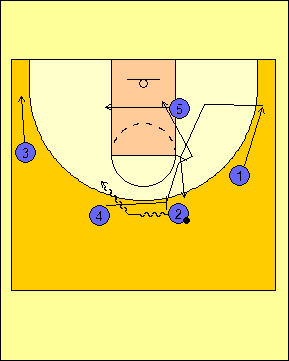
Diagram 20 |
12. "Loop" (Diagrams 21 and 22). This play sets up like Shuffle
except that #3 will go thru the block and come out off of #5's down screen.
Meanwhile, #1 will come off of a down screen set by #4.

Diagram 21 |
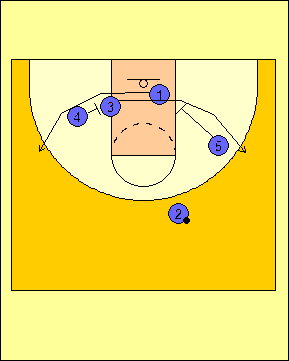
Diagram 22 |
13. "Spur" (Diagrams 23 and 24). This play starts out like
Triple except that #3 will make his cut to the corner opposite #1 once #1 clears
and will run off of a down screen by #5. Whichever side the ball is passed
by #2, the player in the corner and the post will work a post-up game while the
post opposite will back screen #2.

Diagram 23 |

Diagram 24 |
14. "Gator" (Diagram 25). Somewhat similar to Pinch and Dive, #4
will start to the bottom of the free throw circle inside the lane and set a rear
ball screen for #2. #2 can go either way and #5 will move to the side
opposite of #2's decision. #3 and #1 will spot up in the corners.
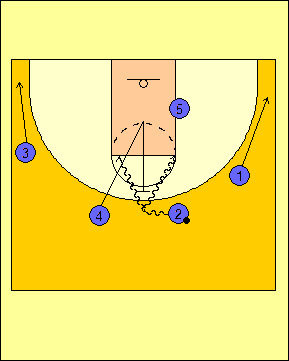
Diagram 25 |
All of the illustrated plays can be run from the Utah set as well if a coach is
so inclined to make that switch. If all are incorporated (which I do not
necessarily recommend) and the "Utah" call is added as a variation of the zipper
set, you have a grand total of 28 plays from which to choose. Also, if you
use the three formations mentioned earlier in the article, you have the option
of using up to 84 different plays.
Teaching the Zipper Offense
The first way we teach the zipper offense is by using Offensive Script.
Here, we will walk through the plays in the zipper offense without a defense.
This way, we can tell each player what their responsibilities are in the offense
and how to run the plays. When that is established for the zipper plays
that we wish to incorporate in our offense, we will then break down the offense
as a part of our whole-part-whole approach to teaching.
In our offensive breakdown period, we can work on the offense with three players
at a time and two players at a time. The three-man group will work on
getting into the zipper or Utah plays while the two-man groups will work on some
of the two-man variations that are included in the offense. Working on
these breakdowns allow the players to learn the offense through our concept of
whole-part-whole teaching while installing the offense.
RETURN TO MEMBERSHIP AREA
© 2010-2017 Alan Peel Enterprises
|